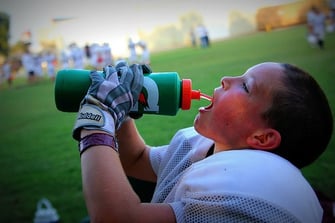Extreme Heat in the News: Several high school football players complained to their coach about being exhausted during a preseason workout. The heat index that day was 94 degrees and it was humid. A 15-year-old lineman began feeling lightheaded and asked the coach for a break. The coach refused, telling the player to push through the pain. A few minutes after his request for a break was denied the boy collapsed. He was unconscious and had a weak pulse. They immediately rushed him to the hospital, but he never regained consciousness and died three days later. The boys’ parents brought charges against the coach and he was put on trial for reckless homicide and wanton endangerment.
Statistics on Heat-Related Illnesses
- Heatstroke kills 10% of its victims.
- Heatstroke can occur within 10 to 15 minutes from the first signs of symptoms.
- With an average of more than 700 deaths annually, extreme heat claims more lives than hurricanes, lightning, tornadoes, floods, and earthquakes combined.
Adverse Health Effects of Extreme Heat
Recognizing the risks and warning signs of extreme heat is crucial in preventing serious, and potentially life-threatening, adverse health effects. Understanding how to respond promptly and appropriately to an individual experiencing heat stress is of the utmost importance. When temperatures and humidity rise, some people are unable to cool themselves properly via sweating and their body temperature rises. If this happens, the following adverse health effects can occur.
Understanding how to respond promptly and appropriately to an individual experiencing heat stress is of the utmost importance. When temperatures and humidity rise, some people are unable to cool themselves properly via sweating and their body temperature rises. If this happens, the following adverse health effects can occur.
Heat-Related Illnesses
Heat Cramps
Heat cramps typically happen when exercise is combined with excessive sweat. This combination lowers the amount of fluid and salt within the body. These low levels in the muscles result in the cramping. Heat cramps may also be an indication of heat exhaustion. Heat cramps usually appear as muscle soreness or spasms, and typically occur in the abdomen, arms, and legs.
An individual experiencing heat cramps should cease all activity and rest in a cool place. Since heat cramps are caused by the loss of salts and fluids it is important to replenish these with either sports drinks or juice. Also, refrain from any strenuous activity for at least 2 hours after the cramp since further exertion could lead to heat exhaustion or heatstroke.
Sunburn
Sunburn occurs when the skin is directly exposed to the sun after an extended period of time without appropriate protection. While the symptoms of sunburn are well-known, such as red, painful, unusually warm areas of skin, it is still important to understand the potential risks of prolonged sun exposure and take appropriate preventative measures. Visit our full list of tips for preventing sunburn for more information.
Heat Rash
Heat rash is a form of skin irritation that appears on the skin as a cluster of red pimples or blisters. Heat rashes typically appear in areas that accumulate higher concentrations of sweat like the neck, chest, back, elbow creases, backs of knees, and groin.
The treatment of heat rash is minimal. If someone notices the symptoms they should keep the rash area dry, find a cool, dry environment, and may apply drying powders to help reduce moisture.
Heat Exhaustion
Heat exhaustion is a milder form of heat-related illness that occurs after prolonged exposure to extreme heat in combination with insufficient fluids. Traditional symptoms are similar, but much milder than the symptoms of heat stroke.
Symptoms of Heat Exhaustion
- Excessive sweating
- Cramping
- Tiredness
- Weakness
- Headaches
- Nausea/vomiting
- Paleness
- Dizziness
- Fainting
Treatment of Heat Exhaustion
While milder than heat stroke, heat exhaustion must still be dealt with swiftly. If someone is experiencing any of the symptoms of heat exhaustion, begin cooling them immediately. Move them into a shaded or air-conditioned room, then give them cool, non-alcoholic liquids. The application of moist towels or a cool bath/shower is also a successful treatment.
Heat Stroke
Heat stroke occurs when the body is no longer able to regulate its own temperature. People suffering from heat stroke are unable to cool themselves by sweating. Once this happens, the body’s temperature can rise in excess of 106 degrees within 10-15 minutes. If not treated properly, heat stroke can result in death or permanent disability.
Symptoms of Heat Stroke
- Extremely high body temperature
- No sweating. Skin will be clammy, red, hot, and dry
- Extreme headaches
- Dizziness
- Fainting
- Nausea/vomiting
- Disorientation
- Rapid pulse
Treatment of Heat Stroke
When someone experiences a heat stroke it is important to act quickly. First, call for emergency medical assistance and then begin cooling the victim. Cool the victim by moving them to a shaded or air-conditioned area. Then directly cool them using whatever methods you have immediately available. Methods including submerging in a tub of cool water (never place in a tub of ice), spray them with cool water from a shower or hose, place cool towels or blankets on the victim, and fan them. Do not give them anything to drink.




